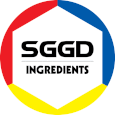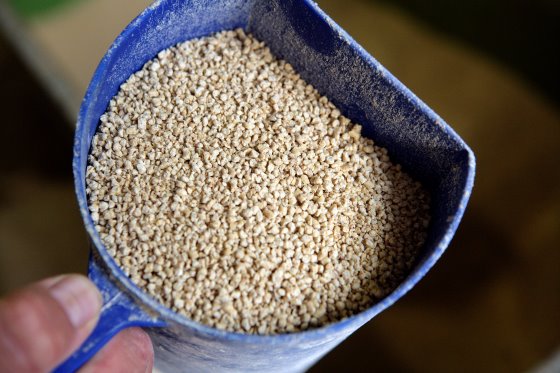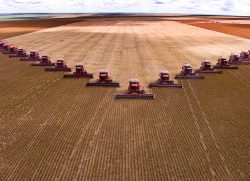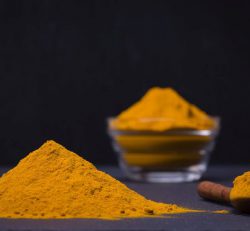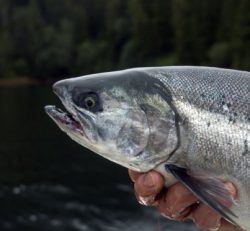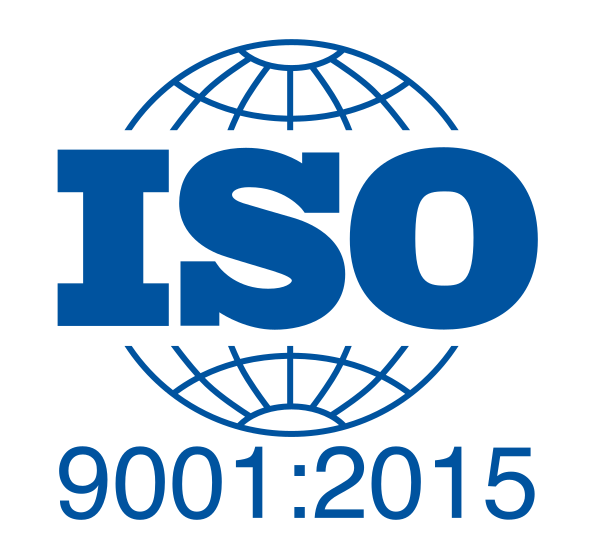LIFE AFTER THE VITAMIN CRISIS
The volatility of vitamin supply has resulted in price increases for certain vitamins. Nevertheless, they remain one of the cheapest additives nutritionists have at their disposal. But don’t go too low in their inclusion level
Vitamins, because they are included at very low levels, usually make up only a small proportion of the cost of the average pig or poultry diet. They can almost never be regarded as nutrients in isolation given that they display a wide range of interlocking interactions, particularly in the case of the B-vitamins which play a key role in both energy and protein metabolism (Bains, 1999).
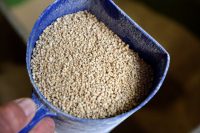
Commercial nutritionists are always interested in financial returns when using ingredients such as vitamins. Photo: Henk Riswick
As anyone involved in animal production will be aware, the supply and hence the cost of certain vitamins have spiked of late. This state of affairs has been brought about through certain factories being closed in China for environmental reasons, followed by an incident at a European producer of vitamins A and E. Happily, the shortage of these critical nutrients has abated. This sequence of events has given us an opportunity to rethink our strategies with regards to vitamin nutrition. In this article, we will examine the current status of vitamin recommendations and ask the question as to whether these recommendations are well founded, appropriate and cost effective.
Current thinking on the requirements
Although vitamins and vitamin deficiencies have been studied for more than a century, it is currently unusual to see individual vitamin deficiencies because of the universal use of vitamins, mostly included in premixes, in modern animal production systems. Sadly, much of the research that we rely on regarding vitamin requirements is limited and/or outdated. The NRC (1994) is considered to be the standard independent reference for vitamins and much of the research contained in this volume was conducted in the decades prior to 1990. Not only were the genotypes used outdated, the diets purified and the animals kept under laboratory conditions but early workers only used body weight gain, feed conversion and mortality as metrics. The modern nutritionist must consider meat yield; the impact nutrients have on the gastro intestinal tract (GIT) and its microbiota and overall animal welfare (food pad and claw condition for example). Table 1 uses a simple demonstration to show just how outdated our recommendations may have become. Clearly, if we wish to achieve the same nutrient intake per gram of gain as was done historically, the level contained in the diet has to increase dramatically.
Table 1: The Impact of broiler genotype on vitamin E intake (inspired by Leeson, 2017).
| 2.5 kg broiler | 1970 | 2018 | 2018 (Corrected) |
| Feed intake (g) | 6000 | 4000 | 4000 |
| Dietary vitamin E (mg/kg) | 50 | 50 | 75 |
| Vitamin E intake (mg/bird) | 300 | 200 | 300 |
| Vitamin E intake (mg/kg body mass) | 120 | 80 | 120 |
By All About Feed
As our genotypes improve and the increased stress modern production systems impose on our animals, requirements are likely to increase in absolute terms (i.e. we will require more nutrient per gram of animal produced). It is speculated, that in an antibiotic free production system, vitamin requirements probably need to be higher than those currently used, especially those components that have anti-oxidant properties. In addition, meat quality is a major consideration for poultry and swine producers. Vitamins E and C have an impact on meat quality through their antioxidant activity and can affect meat quality through oxidative stability of the body tissues and reduce drip losses. In addition, vitamins help prevent meat degeneration (white stripping) that has become more problematic with modern genetics (Bodle, 2018).
Is our thinking still valid?
The level of supplementation has been the subject of many debates between advisers, scientists and feed manufacturers. It is known that issues such as life stage, stress, parasite infestation, and infectious diseases all greatly increase the animals’ requirements for vitamins. In addition, due to significant advantages recorded in performance in various trials, there has been a trend to use higher levels of vitamins. So is our thinking still valid? Most commercial nutritionists have gone through a decision-making process to select what they consider the appropriate vitamin supplementation for the animals under their care.
Table 2: A comparison between the Danish standard vitamin recommendations together with the OVNTM recommendation prescribed by DSM (2016).
| Vitamin/kg feed | Danish Standard | OVN™ |
| Vit A (IU/kg) | 6250 | 15000 |
| Vit D3 (IU/kg) | 750 | – |
| Hy-D (µg/kg) | – | 50 |
| Vit C (mg/kg) | – | 150 |
| Vit E (mg/kg) | 150 | 150 |
| Vit B1 (mg/kg) | 3 | 5 |
| Vit B2 (mg/kg) | 6 | 15 |
| Vit B12 (mg/kg) | 0.03 | 0.06 |
| Biotin (mg/kg) | 0.3 | 0.5 |
| Vit B6 (mg/kg) | 4.5 | 8 |
| Vit K3 (mg/kg) | 4.8 | 6 |
| Niacin (mg/kg) | 30 | 55 |
| Folic Acid (mg/kg) | – | 2.5 |
| D-Pantothenic acid (mg/kg) | 15 | 45 |
| Estimated cost per unit of premix (Euro) | 6.90 | 12.9 |
By All About Feed
During the recent vitamin supply crisis, many nutritionists were obliged to reduce levels due to lack of supply or for financial considerations. The temptation is perhaps to retain these reduced supplementation levels. It would be best to rather consider targeted, elevated levels for a number of reasons:
- It must be assumed that the original levels were selected for sound reasons, and unless the production environment has changed dramatically (for the better), these reasons are still valid.
- Bear in mind that vitamin requirements for dealing with stress or mounting an immune response are high. We cannot wait until such an event occurs, and then simply add additional vitamins to the feed. Rather, elevated levels need to be considered an insurance for the unforeseen.
- Vitamins are known to have an anti-oxidant function in the body, and whilst there is some evidence to suggest that natural anti-oxidants, other than vitamins may be able to partly fulfil this role, refereed scientific data on this topic is still scant, and caution is advised in following this route. There is some evidence to suggest that effective absorption of these molecules is much lower than that of vitamins.
- The genotype of farm animals continues to improve, and they are consuming less feed per kg of product produced with each year that passes. For example, Aviagen have shown that FCR in broilers is reducing by two to three points per year (Avendaño et al., 2017), which means that we should be increasing vitamin levels by 1-2% per year in order to maintain a constant vitamin intake per kg of product produced.
- There is carry over from the breeding animal to its progeny. Lower vitamin levels offered to breeding animals may not impinge on the mother’s performance per se, but it can have a significant impact on the immune-competence and performance of the offspring. In short, consider the vitamin levels included in diets for breeding animals as a high priority.
- The young animal bears particular scrutiny. In broilers, a rapid decline of liver vitamin E levels occurs during the first seven days of life. Young animals are less efficient at absorbing fat-soluble vitamins and therefore, they have a higher dietary requirement. Commercial dietary inclusion levels need to be higher than classical requirements for reasons such as optimising vaccination response. Requirements for vitamins A, E and perhaps vitamin D3 are higher for optimum immune competence compared to the immediate needs for growth (Leeson, 2017).
Table 3: An estimate of the financial return when feeding two different premixes for growth between 7 and 30kg (after Poulsen and Krogsdahl, 2018).
*These figures have been adjusted for the age different. ** It was estimated that the value of a 30 kg pig was 1.7 Euro/kg.
| Control | OVN™-concept | |
| Feed Cost/(Euro ton) | 375 | 381 |
| FCR | 1.40 | 1.38 |
| Exit weight (kg) | 32.59 | 32.82 |
| Age at exit (days) | 46.3 | 45.5 |
| Gain (kg)1 | 25.51 | 26.2 |
| Survivors (%) | 96.47 | 97.78 |
| Salable animal /Pig placed (kg)* | 24.61 | 25.62 |
| Value per pig sold** | 41.84 | 43.55 |
| Total feed Intake/kg pig* | 34.50 | 35.91 |
| Feed Cost for Period | 12.94 | 13.68 |
| Margin/feed cost/animal (Euro) | 28.90 | 29.87 |
| Extra cost of OVN™ per pig (Euro) | – | 0.215 |
| Extra income per pig | – | 0.97 |
| Return per Euro spent | – | 4.50 |
By All About Feed
Practical feeding
Commercial nutritionists are required to make practical decisions as to which vitamin level they should apply to their diets. These decisions can be confusing, and the example of which Vitamin E levels should be used in broiler diets illustrates this. DSM’s OVN™ (2016) suggests a level of 150 to 200 IU/kg, while the primary breeding companies suggest levels of 80 IU/kg. Thus, it was decided to compare the two recommendations in a practical manner. Using the Ross 308 performance parameters and feeding programme (Aviagen, 2014) it was possible to calculate the daily intake of vitamin E per bird.
The differences between the two recommendations are dramatic, with the DSM recommendation resulting in a far higher intake during the starter period, but a lower intake during the grower period (Figure 1). Furthermore, commercial nutritionists are always interested in financial returns. Results of a large semi-commercial trial in pigs, containing vitamin levels either at the Danish standard recommendation or according to DSM’s OVN™ (2016) showed the major differences in these premixes (Table 2). Those animals fed diets containing the OVN™ recommendation exhibited a significant improvement in all production traits measured. As shown in Table 3, the OVN™ premix resulted more than a fourfold increase over the additional cost of the premix used. Similar data for broiler chickens is existent (Perez-Vendrell et al., 2007).
Figure 1 – A comparison between the DSM OVN™ recommendations (2016) and the Aviagen (2014) recommendations with regards to daily vitamin E intake and the intake of vitamin E per kg of bodyweight gain.
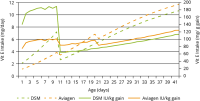
Conclusions
In conclusion, the high vitamin prices experienced of late have called for nutritionists to re-evaluate the vitamin levels included in their premixes. Reducing vitamin levels is not what we want, as the levels we currently use have been arrived at through a process of decision making within each company. Rather, the nutritionist should consider elevated levels, particularly in the diets of young animals of improved genotypes. Any money spent on these animals results in a significant payback.
Rick Kleyn
Poultry Nutritionist Consultant at Spesfeed (Pty) Ltd, South Africa
Source: www.allaboutfeed.net
